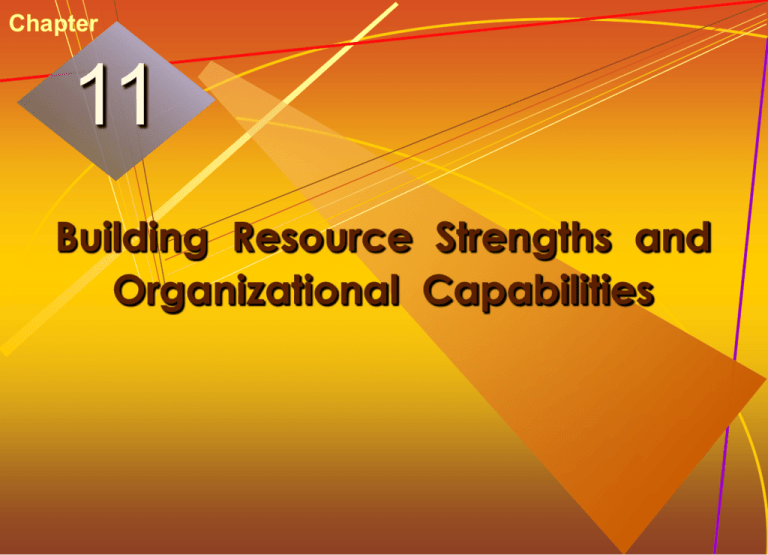
Chapter
11
Building Resource Strengths and
Organizational Capabilities
11-1 McGraw-Hill/Irwin
© 2005 The McGraw-Hill Companies, Inc. All rights reserved.
Crafting vs. Executing Strategy
Crafting the Strategy
Primarily a market-driven
activity
Successful strategy making
depends on
Business vision
Perceptive analysis of
market conditions and
company resources and
capabilities
Attracting and pleasing
customers
Outcompeting rivals
Using company resources
and capabilities to forge a
competitive advantage
11-2 McGraw-Hill/Irwin
Executing the Strategy
Primarily an operations-driven
activity
Successful strategy execution
depends on
Good organization-building
and people management
Creating a strategysupportive culture
Continuous improvement
Getting things done and
delivering good results
© 2005 The McGraw-Hill Companies, Inc. All rights reserved.
Executing the Strategy
An action-oriented, make-things happen task involving
management’s ability to
Direct
organizational change
Implementation
involves . . .
Achieve
continuous improvement in
operations and business processes
Move toward operating excellence
Create
and nurture a
strategy-supportive culture
Consistently
meet or beat performance targets
Tougher and more time-consuming than crafting strategy
11-3 McGraw-Hill/Irwin
© 2005 The McGraw-Hill Companies, Inc. All rights reserved.
Why Executing Strategy Is a
Tough Management Job
The demanding variety of managerial
activities to be performed
Numerous ways to tackle each activity
Requires good people management skills
Requires launching and managing
a variety of initiatives simultaneously
Number of bedeviling issues to be worked out
Battling resistance to change
Hard to integrate efforts of many different work groups
into a smoothly-functioning whole
11-4 McGraw-Hill/Irwin
© 2005 The McGraw-Hill Companies, Inc. All rights reserved.
Implementing a Newly Chosen
Strategy Requires Adept Leadership
Implementing a new strategy
takes adept leadership to
Convincingly
communicate
reasons for the new strategy
Overcome
Build
consensus and enthusiasm
Secure
Get
11-5 McGraw-Hill/Irwin
pockets of doubt
commitment of concerned parties
all implementation pieces in place and coordinated
© 2005 The McGraw-Hill Companies, Inc. All rights reserved.
Who Are the
Strategy Implementers?
Implementing and executing strategy involves a
company’s whole management team and all employees
Just
as every part of a watch plays a role in making the
watch function properly, it takes all pieces of an
organization working cohesively for a strategy
to be well-executed
Top-level managers must lead the process
and orchestrate major initiatives
But they must rely on the cooperation of
Middle and lower-level managers to see that things go
well in the various parts of the organization and
Employees to perform their roles competently on a daily
basis
11-6 McGraw-Hill/Irwin
© 2005 The McGraw-Hill Companies, Inc. All rights reserved.
What Are the Goals of the Strategy
Implementing-Executing Process?
Unite total organization behind strategy
See that activities are done in a manner that is conducive
to first-rate strategy execution
Generate commitment so an enthusiastic
crusade emerges to carry out strategy
Fit how organization conducts its
operations to requirements of strategy
11-7 McGraw-Hill/Irwin
© 2005 The McGraw-Hill Companies, Inc. All rights reserved.
Characteristics of the Strategy
Implementation Process
Every manager has an active role
No proven “formula” for implementing
particular types of strategies
There are guidelines, but no
absolute rules and “must do it
this way” rules
Many ways to proceed that are
capable of working
Cuts across many aspects of “how to manage”
11-8 McGraw-Hill/Irwin
© 2005 The McGraw-Hill Companies, Inc. All rights reserved.
Fig. 11.1: The Eight Actions of
Implementing and Executing Strategy
11-9 McGraw-Hill/Irwin
© 2005 The McGraw-Hill Companies, Inc. All rights reserved.





